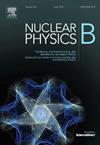幻影BTZ黑洞:摄动修正下的热性质
IF 2.8
3区 物理与天体物理
Q2 PHYSICS, PARTICLES & FIELDS
引用次数: 0
摘要
本研究通过引入由平衡附近的小统计波动引起的前阶微扰修正来研究幻影BTZ黑洞的热力学。从幻影BTZ黑洞回顾开始,我们描述了三维时空中的一种修正作用,包括与麦克斯韦或幻影场的耦合。分析推导出相应的场方程,并得到了度量量和热力学量的精确解。修正后的熵用最陡下降法计算。它是用序熵和霍金温度来表示的。标准热力学关系产生了修正质量、亥姆霍兹自由能、比热和吉布斯自由能。这些修正揭示了与经典结果的显著偏差,特别是在统计效应变得突出的小黑洞区域。图形分析表明,对于足够小的黑洞,修正后的熵变为负值,表明在扰动修正下热力学稳定性的潜在局限性。此外,热波动对小黑洞的影响是巨大的,而对大黑洞的影响可以忽略不计。在本工作中,我们还计算了幻影BTZ黑洞的临界点和临界压缩系数(Zc),并将其视为范德华流体。这项工作提供了对统计波动如何改变幻体BTZ黑洞热力学的全面理解。它强调了在(2+1)维黑洞热力学的现实模型中包含这种修正的必要性。本文章由计算机程序翻译,如有差异,请以英文原文为准。
Phantom BTZ black holes: Thermal properties under perturbative corrections
This study investigates the thermodynamics of phantom BTZ black holes by incorporating leading-order perturbative corrections arising from small statistical fluctuations around equilibrium. Starting from the phantom BTZ black holes review, we describe a modified action in three-dimensional spacetime that includes coupling with a Maxwell or phantom field. The analysis derives the corresponding field equations and obtains exact solutions for the metric and thermodynamic quantities. The corrected entropy is computed using the steepest descent method. It is expressed in terms of the leading-order entropy and Hawking temperature. Standard thermodynamic relations yield the corrected mass, Helmholtz free energy, specific heat, and Gibbs free energy. These corrections reveal significant deviations from classical results, particularly in the small black hole regime where statistical effects become prominent. Graphical analysis shows that the corrected entropy becomes negative for sufficiently small black holes, indicating potential limitations in thermodynamic stability under perturbative corrections. Furthermore, the influence of thermal fluctuations proves substantial for the small black holes and negligible for larger black holes. In this work, we have also calculated critical points and critical compressibility factor () of the phantom BTZ black hole, treating it as a Van der Waals fluid. This work provides a comprehensive understanding of how statistical fluctuations modify the thermodynamics of phantom BTZ black holes. It underscores the necessity of including such corrections in realistic models of black hole thermodynamics in dimensions.
求助全文
通过发布文献求助,成功后即可免费获取论文全文。
去求助
来源期刊

Nuclear Physics B
物理-物理:粒子与场物理
CiteScore
5.50
自引率
7.10%
发文量
302
审稿时长
1 months
期刊介绍:
Nuclear Physics B focuses on the domain of high energy physics, quantum field theory, statistical systems, and mathematical physics, and includes four main sections: high energy physics - phenomenology, high energy physics - theory, high energy physics - experiment, and quantum field theory, statistical systems, and mathematical physics. The emphasis is on original research papers (Frontiers Articles or Full Length Articles), but Review Articles are also welcome.
 求助内容:
求助内容: 应助结果提醒方式:
应助结果提醒方式:


